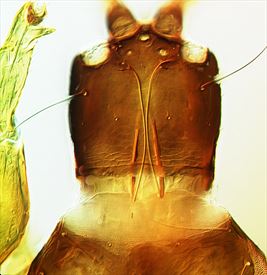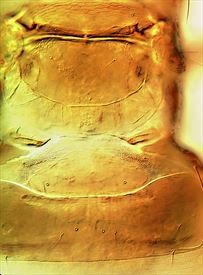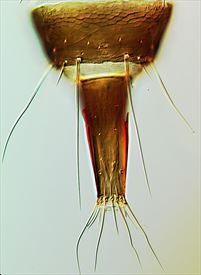Distinguishing features
Female fully winged. Body brown; antennal segment III yellowish-brown, also mid and hind tarsi; fore wing weakly shaded, similar to that of H. corticis; major setae pale. Head with eyes large, cheeks with one or more small, stout setae; maxillary stylets retracted to eyes; postocular setae finely pointed, longer than dorsal eye length. Antennae 8-segmented, segments relatively stout and sense cones short, 3 on segment III and 4 on IV. Pronotal anteromarginal setae no larger than discal setae, midlaterals, epimerals and posteroangulars long and pointed; prosternal basantra absent. Fore tarsal tooth well-developed. Mesopresternum represented by two small sclerites laterally; metathoracic sternopleural sutures short. Pelta broad, posterolateral margins curving away from anterior margin of tergite II; tergites II–VII each with 2 pairs of sigmoid wing-retaining setae; tergite IX posteromarginal setae S1 longer than tube. Female microptera with anterior margin of compound eyes slightly flattened; pronotal setae very long, wing-retaining setae small; metanotum with no sculpture.
Male microptera similar to female; sternite VIII with transverse pore plate extending posterolateral to spiracles; tergite IX setae S2 short and stout.
Related species
The genus Hoplothrips comprises about 130 species worldwide, of which 7 are recorded from New Zealand. Several of these appear to be endemic to this country, but corticis is from the Northern Hemisphere and orientalis is probably from Asia. H. poultoni is similar to H. corticis in structure, but the setae on tergite IX are exceptionally long, and the anterior pair of tergal wing-retaining setae are reduced.
Biological data
Like other members of Hoplothrips, this species is a fungus-feeder on dead branches.
Distribution data
There is only one record of this species in New Zealand (CO). Described originally on a single winged female from Melbourne, Australia, a series of micropterae of both sexes was collected at Canberra in 1961.
Family name
PHLAEOTHRIPIDAE, PHLAEOTHRIPINAE
Species name
Hoplothrips poultoni (Bagnall & Kelly)
Original name and synonyms
Trichothrips poultoni Bagnall & Kelly, 1929: 90
References
Mound LA & Walker AK (1986) Tubulifera (Insecta: Thysanoptera). Fauna of New Zealand 10: 1–140.


